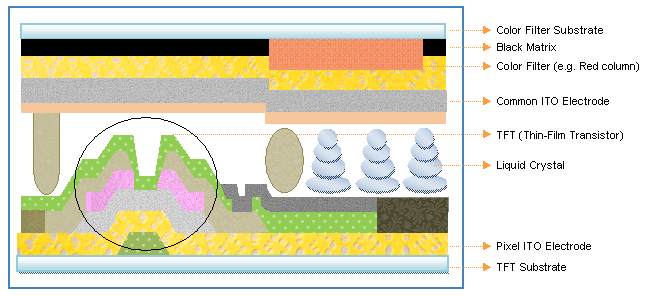 |
|
 |
 Overview of TFT-LCD modules Overview of TFT-LCD modules
TFT-LCD panel
TFT-LCD panel technicality
TFT-LCD is the mainstream type of display panel (also referred to as a cell) used for smart phones. The TFT-LCD basically consists of two layers of glass substrates sandwiching a layer of liquid crystals. The top glass substrate is fitted with a colour filter and the bottom glass substrate has transistors fabricated on it. Polarisers are also attached to both sides of the panel.

Components and functions
TFT array: The bottom substrate is referred to as the TFT array. It is made of many individual transistors that are made of semiconductor materials, usually silicon. They function as a gatekeeper, controlling the amount of voltage generated by the driver IC that is passed between the ITO layers. The TFT array passes on voltage (electronic signals) through the liquid crystal layer so that the liquid crystals can be twisted by the voltage value trapped between the pixel ITO and common ITO.
CF array: An array of colour filters is coated on the inner surface of the upper glass panel (e.g. the panel facing the viewer) which allows the images to be displayed in colour. The colour filter acts as a light valve, controlling the transmission of light through an electric voltage. An array of light valves are used to display monochrome images (e.g. with bright and dark pixels). To display colour information, an array of colour filters consisting of three primary colours, RGB, needs to be placed after the array of light valves. This divides each pixel of the display into three cells or sub pixels which are coloured RGB. Each sub pixel can be controlled to yield thousands or millions of possible colours for each pixel.
ITO electrode: The ITO electrode is a transparent material that exhibits good electrical conductivity. There are usually two ITOs — common ITO and pixel ITO that are placed on either side of the liquid crystal layer, acting as the electric field. It passes the voltage from the TFT array through the liquid crystals.
Liquid Crystals: Liquid crystals are birefringent materials, meaning it can split light rays. When light travels through the liquid crystals, it undergoes retardation, twisting to form a helical pattern, whereby the intensity of light can be modulated. When voltage of different strengths is applied, the liquid crystals will go through different phase retardations, untwist, changing the polarisation and blocking the light’s path. This creates gray scale, or lights of different intensity.
|
|

























